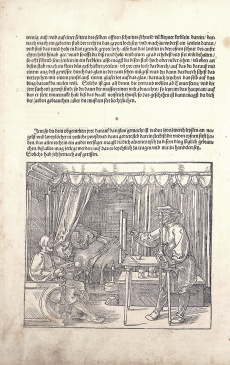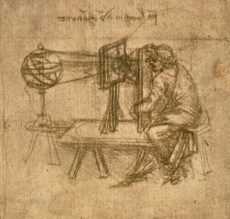Glass
From Inventions
Name adopted since the fifteenth century (documented already by Leonardo da Vinci).
Contents |
Inventor
perhaps Leonardo da Vinci (1452-1519)
Historic Period
XV century
Description
A simple pane of glass held by a frame used since the fifteenth century to portray objects and figures in perspective. Leonardo, who may have invented it, gives a first description of the device: “Have a piece of glass as large as a half sheet of royal folio paper and set thus firmly in front of your eyes, that is, between your eye and the thing you want to draw. Then place yourself at a distance of 2/3 of a braccia from the glass fixing your head with a machine in such a way that you cannot move it at all. Then shut or entirely cover one eye and with a brush or red chalk draw upon the glass that which you see beyond it; then trace it on paper from the glass, afterwards transfer it onto good paper, and paint it if you like, carefully attending to the aerial perspective.” (Codex Atlanticus 1r-a; Richter, par. 523). More clearly detailed is the description of the instrument in Albrecht Dürer’s treatise on geometry: “...but now I will demonstrate how to draw what you see through a glass” (Underweisung der messung, Nuremberg, 1525, IV). Some drawings dated by the artist show that Dürer finalized his version in 1515, calling the instrument by the name “glass”. It was then described and illustrated by various authors during the Renaissance.
Bibliographical Resources
Leonardo da Vinci. The literary works of Leonardo da Vinci. Compiled and edited from the original manuscripts by Jean Paul Richter. London, Phaidon, 1970, I, par. 523.
Leonardo da Vinci. Il Codice Atlantico di Leonardo da Vinci: edizione in facsimile dopo il restauro dell'originale conservato nella Biblioteca Ambrosiana di Milano. Firenze : Giunti Barbèra, 1973-1975, c. 1r-a (o 5r?).
Dürer, Albrecht. Underweysung der messung mit dem zirckel vnd richtscheyt in Linien ebnen vnnd gantzen corporen durch Albrecht Duerer zusamen getzogen vnd zu nutz aller kunstlieb habenden mit zu gehoerigen figuren in truck gebracht im jar. 1525. Gedruckt zu Nueremberg, Hieronymus Andreae, 1525.
Alberti Durereri Institutionum geometricarum libri quatuor: in quibus, lineas, superficies, et solida corpora, ita tractavit, ut non matheseos solúm studisosis, sed et pictoribus, fabris aerariis ac lignariis, lapicidis, statuariis, et universis demúm qui circino, gnomone, libella, aut alioqui certa mensura opera sua examinant, sint summé utiles et necessarii. Arnhemiae, Ex officina Iohannis Iansonii, 1606, IV.
Faulhaber, Johann. Mathematici tractatus duo nuper germanice editi, Joannis Faulhaberi, ulmae arithmetici ingeniosissimi, continens, prior, novas Geometricas et opticas aliquot singularium instrumentorum inventiones, posterior, usum instrumenti cuiusdam Belgae de novo excogitatum, dimetiendis et describendis rebus aptum, et nostratum et exterorum magnatum et ducum philomathematicorumque gratia latino versi, per Ioannem Remmelinum.Francofurti, sumptibus Antoni Hummi, 1610, p. 35.
Stevin, Simon. De sciagraphia, Leida 1605, cap. 7.
Images
Author of the entry: Filippo Camerota


